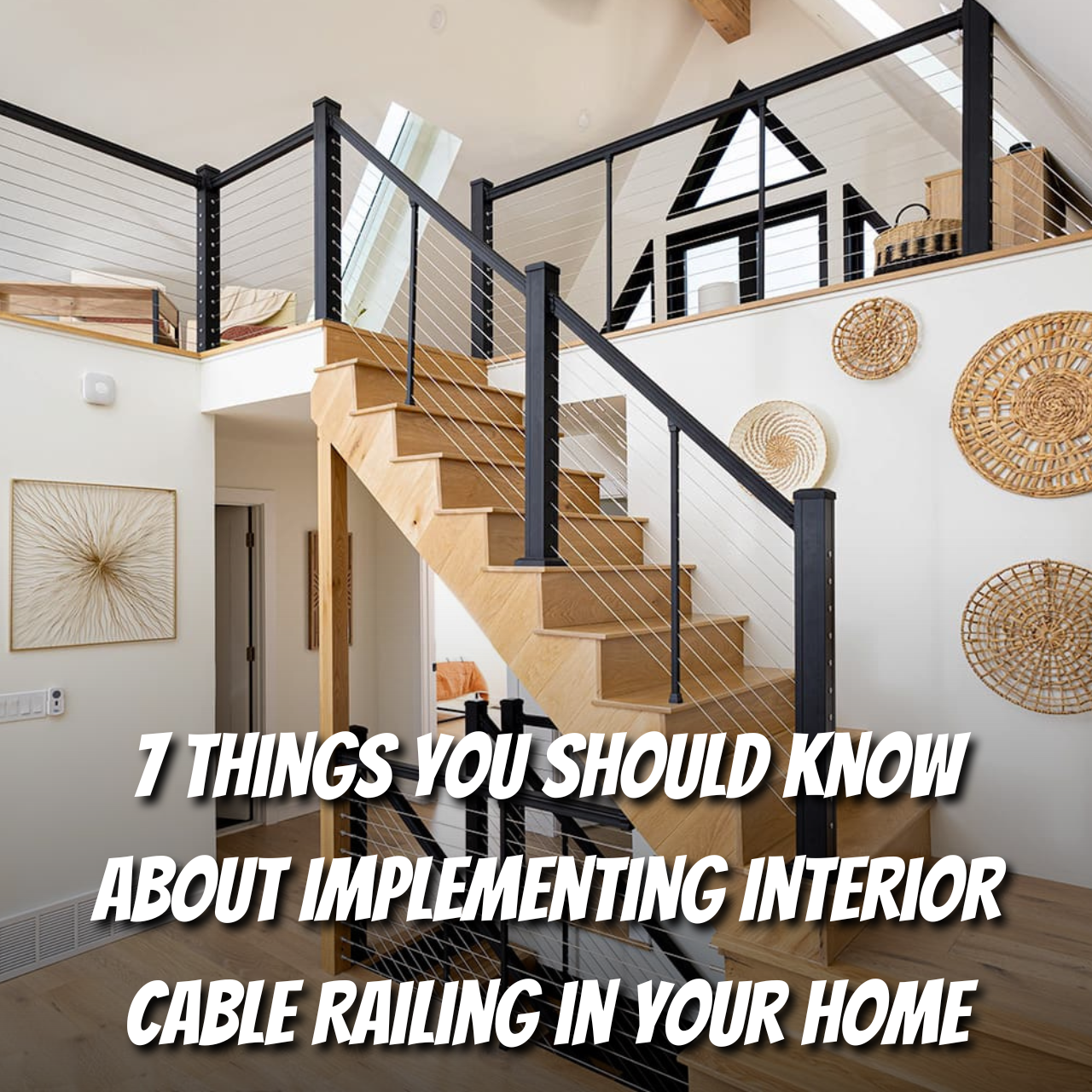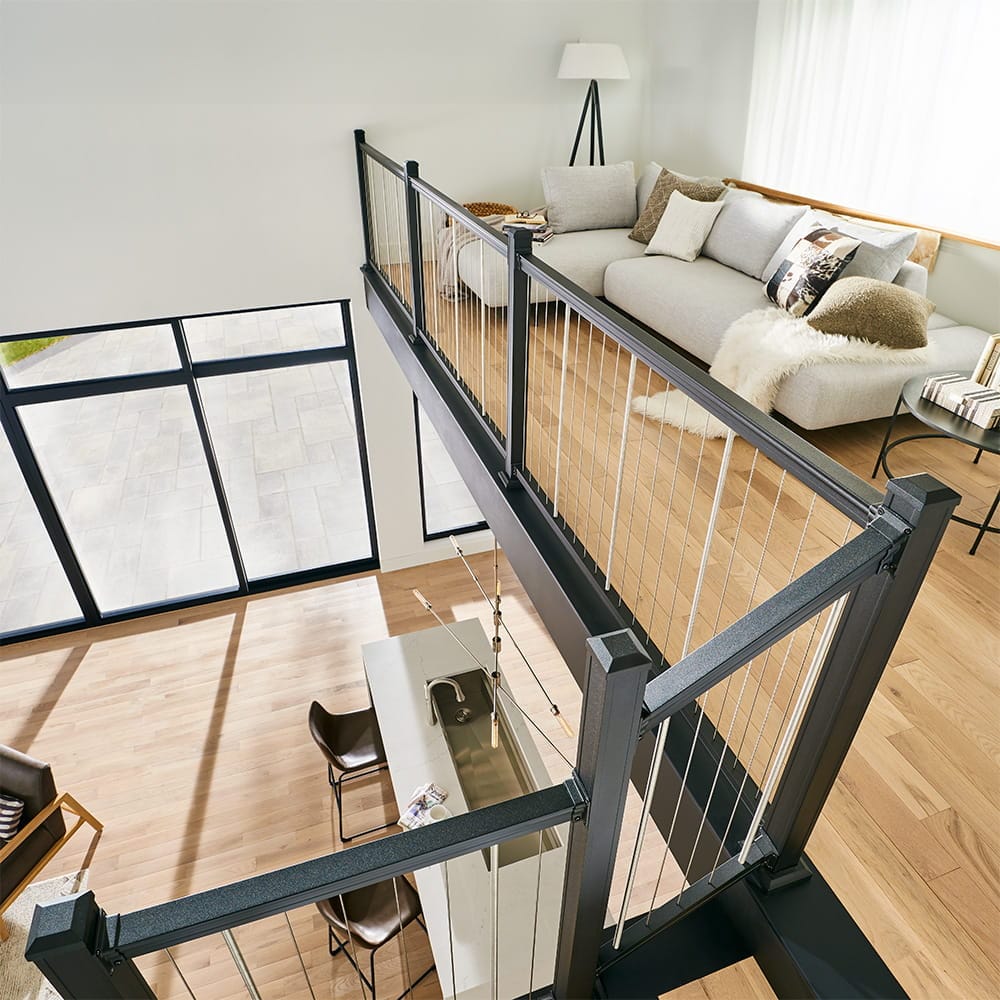7 Things You Should Know About Implementing Interior Cable Railing in Your Home

As the founder of an independent retailer that has sold railing systems for over 13 years, I’m familiar with nearly every major brand in the industry. My personal preference for interior spaces is Keylink, because of its superior craftsmanship, lifetime warranty, and customizability that allows homeowners and designers to tailor projects to their needs.
This guide is built for homeowners and designers planning interior cable railing. Each section explains a practical benefit, why it matters, and how to make the right choice with Keylink’s American and Chesapeake systems.
1) Sightlines and light without a “showpiece” rail
Cable railing should frame the room, not compete with it.
Bulky guards steal attention from floors, cabinetry, and views. Cable infill uses 1/8″ stainless lines that read as thin grid lines from a few feet away. This keeps lofts and stairs open and bright. In compact homes or A-frames with limited wall space, cable rails add breathing room without altering the architecture.

2) Blending indoor and outdoor living with one railing system
Designers are leaning into blended living spaces that connect interiors and exteriors seamlessly.
Repeating materials and finishes across inside and outside makes a home feel larger and less segmented. Cable railing makes this easy: one system can run from an interior stair to a deck or balcony without feeling disjointed. That continuity supports a smoother daily flow and strengthens your whole-home design story.
Shared living spaces also change how you host. A deck off a dining room or kitchen becomes an effortless extension of the interior. Add a drink rail to a section of the deck to create a natural place for guests to gather. Inside, use the same wood top on your guard to match flooring or cabinetry. The result is a unified, versatile space that feels welcoming and connected, whether you’re serving dinner indoors or cocktails outdoors.
Because Keylink systems are engineered for both environments, you can keep one series and one finish across the project. That means fewer decisions, consistent color, and a design that reads as one project from entry to exterior.
3) Choosing American vs. Chesapeake for interiors
Both work indoors. Choose by hand feel and the look you want.
American Series: Pick this if you want a slimmer profile that feels light and is easy to grasp. It suits modern interiors where you want the guard to read as minimal as possible and corners to feel clean.
Chesapeake Series: Choose this if you plan to add a wood top rail to tie into flooring, cabinetry, or beams. It’s the right fit when you want the guard to blend with existing design elements and feel more furniture-like.
See details on Chesapeake Series horizontal cable.

4) Matte and satin finishes blend with your design elements
Interior finishes should complement, not compete with your design. Matte and satin coatings reduce glare under interior lighting and pair naturally with stone, flooring, and cabinetry.
Keylink recently expanded its palette with new satin finishes, responding to growing demand from designers and homeowners who wanted finishes beyond the typical black/bronze/white offerings. These additions have quickly become some of the most popular options for interior spaces. These satin finish work in a wide range of settings, blending with a variety of industrial and organic materials.
Matte Black and Matte White continue to be widely popular, but we’re seeing more and more people looking for variety and customizability in their choice of colors. Among the most requested colors: Oil Rubbed Bronze, which pairs well with wood floors and darker tones, and Satin Storm, which complements stone and granite surfaces.

5) Wood top strategy that ties into your floors and millwork
A wood cap makes the rail feel built in and warm to the touch.
Chesapeake’s design lets you add a hardwood cap directly to the rail. This reads as a built-in element rather than a bolt-on part. Match oak, maple, or walnut to floors, beams, or the kitchen island. Pair Satin Storm with stone, or Oil Rubbed Bronze with darker woods. If stairs need a graspable handrail, add a wall-mounted secondary rail to stay code compliant while keeping the flat wood cap on the guard.
6) When vertical cable is the smarter interior choice
Short runs change the math. Vertical panels keep the look and speed the job.
Horizontal cable is efficient on long runs. Most interior spans are short, which can raise cost per foot. Keylink’s vertical cable panels solve this with factory pre-strung 6′ or 8′ sections. They install fast and keep the transparency you expect from cable. Keylink now offers black vertical cable infill. Pair it with a Matte Black frame for a premium, low-glare look that recedes into the room.
7) Install and code basics that prevent rework
A few checks up front save hours later.
- Match 36″ or 42″ guard heights to the rest of the home.
- Use the correct stair brackets for your angle range.
- For 36″ guards, plan 38″ posts on level runs and taller posts on stair lines.
- Tension cables evenly to prevent sag and noise.
- Wipe rails and cables after install. Coated black cable needs approved cleaners.
For more detail, see our Cable Railing Code Compliance guide.
Ready to spec your interior railing?
Send a plan or photo. We’ll recommend posts, brackets, finish, and cable type.
Get a Free QuoteFrequently Asked Questions
Can I match the deck railing to my interior stair?
Yes. Use the same Keylink series and color to tie spaces together.
Which finishes work best indoors?
Matte and satin finishes. They reduce glare and blend with lighting, flooring, and cabinetry.
When should I consider vertical cable?
On short runs and stairs. Pre-assembled panels simplify layout and tensioning.
Can I add a wood cap to cable railing?
Yes, on Chesapeake. Match it to flooring or cabinetry for a built-in look.
Do I need special cleaners for black cable?
Yes. Use approved cleaners for coated cable, not standard stainless cleaners.
About the Author: Jonathon Sims is the founder of Inso Supply, an independent retailer specializing in premium railing systems. With more than 13 years of experience helping homeowners, contractors, and designers, he has seen how the right railing can transform a project. His recommendation of Keylink for interior applications comes from its superior craftsmanship, lifetime warranty, and the ability to customize finishes and layouts to fit any home.



Leave a comment